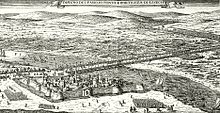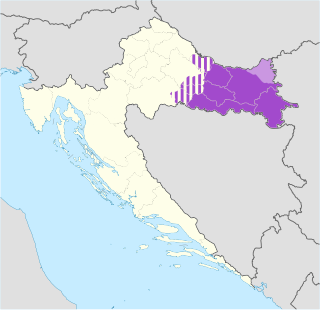
Slavonia is, with Dalmatia, Croatia proper, and Istria, one of the four historical regions of Croatia. Taking up the east of the country, it roughly corresponds with five Croatian counties: Brod-Posavina, Osijek-Baranja, Požega-Slavonia, Virovitica-Podravina, and Vukovar-Syrmia, although the territory of the counties includes Baranya, and the definition of the western extent of Slavonia as a region varies. The counties cover 12,556 square kilometres or 22.2% of Croatia, inhabited by 806,192—18.8% of Croatia's population. The largest city in the region is Osijek, followed by Slavonski Brod and Vinkovci.

Valpovo is a town in Slavonia, Croatia. It is close to the Drava river, 25 km (16 mi) northwest of Osijek. The population of Valpovo is 7,406, with a total of 11,563 in the municipality.

The Military Frontier was a borderland of the Habsburg monarchy and later the Austrian and Austro-Hungarian Empire. It acted as the cordon sanitaire against incursions from the Ottoman Empire.

Virovitica County was an administrative subdivision of the Medieval Kingdom of Croatia, the Kingdom of Slavonia and the Kingdom of Croatia-Slavonia. Slavonia was an autonomous kingdom within both Croatia and Hungary, themselves within the Habsburg Monarchy/Austrian Empire; Croatia-Slavonia, its successor, was an autonomous kingdom within the Lands of the Crown of Saint Stephen (Transleithania), the Hungarian part of Austria-Hungary. Its territory is now in eastern Croatia. The name of the county comes from the town of Virovitica. The capital of the county moved from Virovitica to Osijek in the late 18th century.

The Great Turkish War, also called the Wars of the Holy League, was a series of conflicts between the Ottoman Empire and the Holy League consisting of the Holy Roman Empire, Poland-Lithuania, Venice, Russia, and the Kingdom of Hungary. Intensive fighting began in 1683 and ended with the signing of the Treaty of Karlowitz in 1699. The war was a defeat for the Ottoman Empire, which for the first time lost substantial territory, in Hungary and the Polish–Lithuanian Commonwealth, as well as in part of the western Balkans. The war was significant also for being the first instance of Russia joining an alliance with Western Europe.

The Kingdom of Slavonia was a kingdom of the Habsburg monarchy and the Austrian Empire that existed from 1699 to 1868. The kingdom included northern parts of present-day regions of Slavonia and Syrmia. The southern parts of these regions were part of the Slavonian Military Frontier, which was a component of the Military Frontier separating the Habsburg monarchy from the Ottoman Empire.

The Second Battle of Mohács, also known as the Battle of Harsány Mountain, was fought on 12 August 1687 between the forces of Ottoman Sultan Mehmed IV, commanded by the Grand-Vizier Sari Süleyman Paşa, and the forces of Holy Roman Emperor Leopold I, commanded by Charles of Lorraine. The result was a decisive victory for the Austrians.

The Battle of Petrovaradin also known as the Battle of Peterwardein, took place on 5 August 1716 during the Austro-Turkish War when the Ottoman army besieged the Habsburgs-controlled fortress of Petrovaradin on the Military Frontier of the Habsburg monarchy. The Ottomans attempted to capture Petrovaradin, the so-called Gibraltar on the Danube, but experienced a great defeat by an army half the size of their own, similar to the defeat they had experienced in 1697 at Zenta. Ottoman Grand Vizier Damad Ali Pasha was fatally wounded, while the Ottoman army lost 20,000 men and 250 guns to the Habsburg army led by Field Marshal Prince Eugene of Savoy.

The Kingdom of Croatia was part of the Lands of the Hungarian Crown, but was subject to direct Imperial Austrian rule for significant periods of time, including its final years. Its capital was Zagreb. It was also a part of the lands of the Habsburg monarchy from 1527, following the Election in Cetin, and the Austrian Empire from 1804 to 1867.

The Battle of Gorjani or Battle of Đakovo was a battle fought on 9 October 1537 at Gorjani, a place in present-day Slavonia, between the towns of Đakovo and Valpovo, as part of the Little War in Hungary as well as the Hundred Years' Croatian–Ottoman War.

The Hundred Years' Croatian–Ottoman War is the name of a sequence of conflicts, mostly of relatively low intensity, between the Ottoman Empire and the medieval Kingdom of Croatia, and the later Habsburg Kingdom of Croatia. Except for periods of "small" borderland warfare, the conflict also saw episodes of major conquest campaigns of Croatian land undertaken by the Ottomans especially during the 16th century.

The House of Pejačević or Pejácsevich is an old Croatian noble family, remarkable during the period in history marked by the Ottoman war in the Kingdom of Croatia and Austro-Hungarian Empire respectively. Notable members of the family were politicians, clerics, artists, senior military officers, Bans (viceroys) of Croatia and other high state officials. They were very potent and influential in the political, social, economic and cultural life of the country, and especially distinguished in the region of Slavonia. In German and Spanish, the family name was sometimes rendered Pejacsevich, i.e. a simplified variant of the Hungarian spelling.
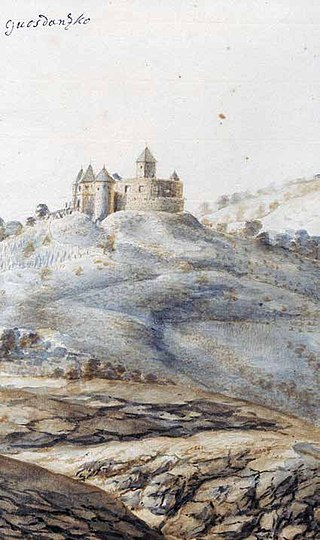
The siege of Gvozdansko was an Ottoman siege of the fort of Gvozdansko in the Kingdom of Croatia in 1577–1578. In the 1570s, the Ottomans intensified their efforts to capture the valley of the Una River. A string of forts along the Una, centred around Gvozdansko and in possession of the Zrinski noble family, formed the main line of defense of Croatia since 1527. The fort held off Ottoman attacks in 1540 and 1561.

Katzianer's Campaign or Katzianer's War was a failed 1537 Habsburg attempt of driving the Ottomans away from the region of Slavonia in modern-day Croatia. Despite being well resourced, Katzianer's army failed to achieve any objectives and it was ultimately completely annihilated in the Battle of Gorjani.
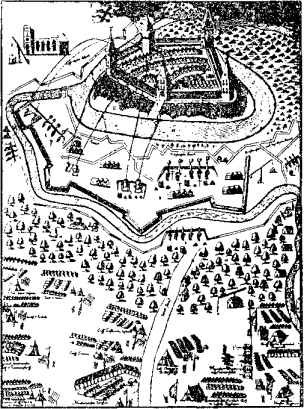
The siege of Virovitica was one of the first battles of Croatian–Slavonian theater during Great Turkish War. The siege took place in July 1684, and it ended with the Ottoman garrison's surrender and Habsburg-Croatian capture of town. Due to its capture in early phase of the war, the town became a vital Habsburg base for further operations in Slavonia.
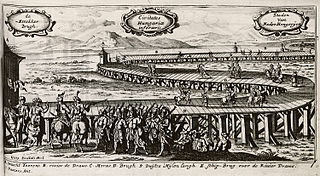
Croatian-Slavonian theater in Great Turkish War, concerns military operations undertaken during Great Turkish War of 1684-1689 by the forces of Holy League against the Ottoman Empire on territories of Croatia, Slavonia and Dalmatia. The war was concluded by Treaty of Karlowitz in 1699, which significantly eased off the Ottoman grip off Croatia.

Siege of Bihać (1697) was a Habsburg siege of the Ottoman fortress town of Bihać in Bosnian Krajina. The siege was planned as a diversionary attack from main Habsburg offensive on Danube river, and was called off after several failed storming attempts.
The Battle of Derventa was a battle between the Holy Roman Empire and Ottoman Empire on 5 September 1688. It ended in a Holy Roman Empire victory.
Ivan Andrija Makar of Makarska (c.1640–1700) was a 17th-century Croatian general, Habsburg Military Frontier commander, Križevci capitancy commander and haramije leader.
